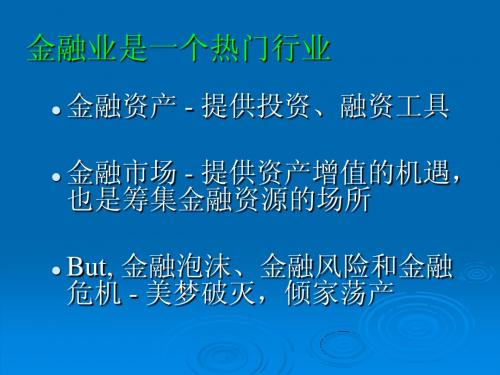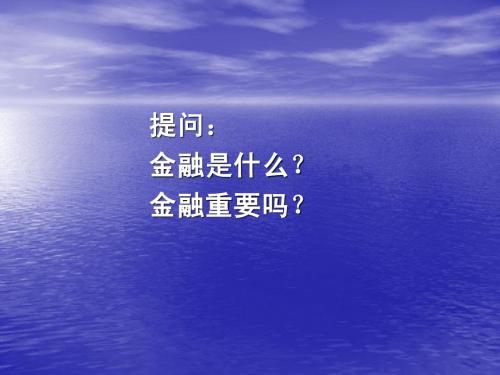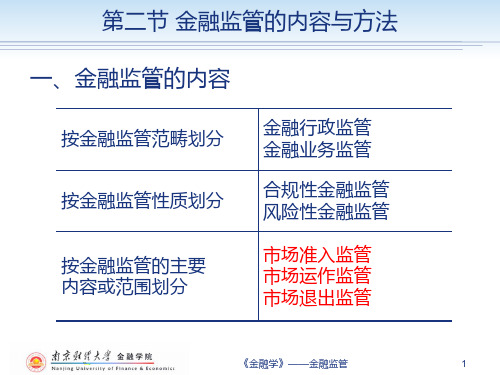Lecture 01 金融概述
- 格式:ppt
- 大小:737.50 KB
- 文档页数:32


金融英语Lecture1MoneyMoneyIf you can actually count your money, then you are not really a rich man.——American oil billionaire J. Paul GettyWhat is money?Economists define money as anything that is generally accepted in payment for goods or services or in the repayment of debts.Types of moneyA. Commodity moneyB. Convertible paper moneyC. Fiat money(or fiat currency):Usually paper money, is a type of currency whose only value is that a government made a fiat that the money is a legal method of exchange.Unlike commodity money or representative money it is not based in another commodity such as gold or silver and is not covered by a special reserve.D. Private debt moneyE. Electronic moneyPrivate debt moneyA loan that the borrower promises to repay in currency on demand.E.g. IOU the checkable deposit at commercial banks and other financial institutions.Commercial notes(商业票据):Short-term, unsecured, discounted, and negotiable notes sold by one company to another in order to satisfy immediate cash needs.Include: promissory note (期票,拮据) draft (汇票) check and so on. Electronic money: Electronic Check, Internet Payment System, Credit Card ServiceWhat does money do?A. Medium of ExchangeIn almost all market transactions in our economy, money in the form of currency or checks is a medium of exchange; it is used to pay for goods and services. The use of money as a medium of exchange promotes economic efficiency by eliminating much of the time spent in exchanging goods and services.Terms: Transaction cost, Time value of moneyB. Unit of AccountThe second role of money is to provide a unit of account; that is, it is used to measure value in the economy. We measure the value of goods and services in terms of money, just as we measure weight in terms of pounds or distance in terms of miles.Note: Fiat money has not only no particular value in use; it doesn't even really have a value in exchange except that which is decreed that it would have.Terms: Good money, Bad moneyC. Store of ValueMoney also functions as a store of value: it is a repository of purchasing power over time. It is an asset. It 's something that we can use to store value away to be retrieved at a later point in time. So we can not consume today, we can hold money instead - and transfer that consumption power to some point in the future.Term: Hard currencyMeasuring Monetary Aggregates1. Measure as “money” only those assets that are most liquid, hence that function best as a medium of exchange.2. Include all financial assets in the measure of money, but weight them in proportion to their liquidity.1. M1 = Most Narrow Measure (Most Liquid)M1 = currency + traveler’s checks + demand deposits + other checkable deposits2. M2 = M1 + Less Liquid AssetsM2 = M1 + small denomination time deposits + savings deposits + money market deposit accounts + money market mutual fund shares3. M3 = M2 + Less Liquid AssetsMoney supplyThe revenue raised through the printing of money. When the government prints money to finance expenditure, it increases the money supply. The increase in the money supply, in turn, causes inflation. Printing money to raise revenue is like imposing an inflation tax.To expand the money supply:The Federal Reserve buys Treasury Bonds and pays for them with new money.To reduce the money supply:The Federal Reserve sells Treasury Bonds and receives the existing dollars and then destroys them.InflationInflation is an increase in the average level of prices, and a price is the rate at which money is exchanged for a good or service.Here is a great illustration of the power of inflation:In 1970, the New York Times cost 15 cents, the median price of a single-family home was $23,400, and the average wage in manufacturing was $3.36 per hour. In 2008, the Times cost $1.50,the price of a home was $183,300, and the average wage was $19.85 per hour.Hyperinflation is defined as inflation that exceeds 50 percent per month, which is just over 1 percent a day.Questions1. Money is not unique as a store of value; any asset, be it money, stocks, bonds, land, houses, art, or jewelry, can be used to store wealth.Many such assets have advantages over money as a store of value: They often pay the owner a higher interest rate than money, experience price appreciation, and deliver services such as providing a roof over one's head. If these assets are a more desirable store of value than money, why do people hold money at all?The answer to this question relates to the important economic concept of liquidity.2. Rank the following assets from most liquid to least liquid:a.Checking account depositsb. Housesc. Currencyd. Washing machinese. Savings depositsf. Common stock3. Why have some economists described money during a hy perinflation as a “hot potato” that is quickly passed from one person to another?4. Was money a better store of value in the United States in the 1950s than it was in the 1970s? Why or why not? In which period would you have been more willing to hold money?5. In Brazil, a country that was undergoing a rapid inflationbefore 1994, many transactions were conducted in dollars rather than in Reals, the domestic currency. Why?Quiz1. Fiat money is:A. credit card chargesB. CoinsC. not convertible into precious metals.D. checksAnswer: C2. Which of these is not a function of money in an economy?A. Store of valueB. Medium of exchangeC. Source of incomeD. Unit of account Answer:C3. Which of the following is not part of M1?A. checking accountsB. traveler's checksC. savings accountsD. currency Answer:C4. If Mary deposits $100 of her currency in her checking account, then:A. M1 will increase by $100.B. M2 will fall by $100.C. M1 and M2 will not change.D. M2 will increase by $100. Answer:C5. If Mary moves $100 from her savings account to her checking account, then:A. M1 will not change.B. M2 will not change.C. M1 will fall by $100.D. M2 will fall by $100. Answer:B6. Which of the following is not part of M2?A. Small time depositsB. CurrencyC. Institutional money market mutual fundsD. Saving accounts Answer:C7. Inefficiencies that are created when using checks as money include:A. Checks can transfer funds slowly.B. There are too many bad checks written.C. Checkbooks can be stolen.D. Checks can be written for any amount.Answer:A8. The liquidity of an asset is:A. the ability of an asset to earn interest income.B. the amount of an asset sold at discount or premium.C. the relative ease with which an asset can be converted into a medium of exchange.D. the relative ease with which an asset can be converted into a common stock.Answer:C9. For a commodity to function effectively as money, it mustA. Be widely accepted.B. Be backed by gold or silver.C. Be indestructible.D. Be printed by the government. Answer:A10. Money supply data is generated by:A. The Department of CommerceB. The Federal Deposit Insurance Corporation (FDIC)C. The Federal Reserve System (the Fed)D. The Treasury DepartmentAnswer:C11. Which of the following correctly shows the evolution of the payments system?A. Commodity money, fiat money, checks, electronic money.B. Commodity money, fiat money, electronic money, checks.C. Commodity money, checks, fiat money, electronic money.D. Fiat money, commodity money, checks, electronic money. Answer:A12.Which of the following is true regarding money's store of value function?A. money does not allow a person to hold purchasing power from the time income is earned until it is spent.B. money is the only store of value available.C. money is the most liquid store of value available.D. money is superior to all other stores of value during periods of inflation.Answer:C13. Which of the following is not a disadvantage of electronicmoney?A. People are concerned about the privacy and security of e-money transactions.B. E-money transactions cost more than paper check transactions.C. The cost of setting up a system for processing e-money payments is high.D. E-money does not allow people to take advantage of float. Answer:B14. Wealth isA. Generally accepted for the repayment of debtsB. A flow of earnings per unit of timeC. A stock conceptD. The total collection of pieces of property that serve to store value Answer:D15. The Fed's measurements of monetary aggregatesA. Are more reliable in the short run than the long run.B. Are revised once a year.C. Does not depend on the definition of money.D. Are more reliable in the long run than the short run.Answer:D。




金融英语L e c t u r e1M o n e yMoneyIf you can actually count your money, then you are not really a rich man.——American oil billionaire J. Paul GettyWhat is money?Economists define money as anything that is generally accepted in payment for goods or services or in the repayment of debts.Types of moneyA. Commodity moneyB. Convertible paper moneyC. Fiat money(or fiat currency):Usually paper money, is a type of currency whose only value is that a government made a fiat that the money is a legal method of exchange. Unlike commodity money or representative money it is not based in another commodity such as gold or silver and is not covered by a special reserve.D. Private debt moneyE. Electronic moneyPrivate debt moneyA loan that the borrower promises to repay in currency on demand. E.g. IOU the checkable deposit at commercial banks and other financial institutions.Commercial notes(商业票据):Short-term, unsecured, discounted, and negotiable notes sold by one company to another in order to satisfy immediate cash needs.Include: promissory note (期票,拮据) draft (汇票) check and so on. Electronic money: Electronic Check, Internet Payment System, Credit Card ServiceWhat does money do?A. Medium of ExchangeIn almost all market transactions in our economy, money in the form of currency or checks is a medium of exchange; it is used to pay for goods and services. The use of money as a medium of exchange promotes economic efficiency by eliminating much of the time spent in exchanging goods and services.Terms: Transaction cost, Time value of moneyB. Unit of AccountThe second role of money is to provide a unit of account; that is, it is used to measure value in the economy. We measure the value of goods and services in terms of money, just as we measure weight in terms of pounds or distance in terms of miles.Note: Fiat money has not only no particular value in use; it doesn't even really have a value in exchange except that which is decreed that it would have.Terms: Good money, Bad moneyC. Store of ValueMoney also functions as a store of value: it is a repository of purchasing power over time. It is an asset. It 's something that we can use to store value away to be retrieved at a later point in time. So we can not consume today, we can hold money instead - and transfer that consumption power to some point in the future.Term: Hard currencyMeasuring Monetary Aggregates1. Measure as “money” only those assets that are most liquid, hence that function best as a medium of exchange.2. Include all financial assets in the measure of money, but weight them in proportion to their liquidity.1. M1 = Most Narrow Measure (Most Liquid)M1 = currency + traveler’s checks + demand deposits + other checkable deposits2. M2 = M1 + Less Liquid AssetsM2 = M1 + small denomination time deposits + savings deposits + money market deposit accounts + money market mutual fund shares3. M3 = M2 + Less Liquid AssetsMoney supplyThe revenue raised through the printing of money. When thegovernment prints money to finance expenditure, it increases the money supply. The increase in the money supply, in turn, causes inflation. Printing money to raise revenue is like imposing an inflation tax.To expand the money supply:The Federal Reserve buys Treasury Bonds and pays for them with new money.To reduce the money supply:The Federal Reserve sells Treasury Bonds and receives the existing dollars and then destroys them.InflationInflation is an increase in the average level of prices, and a price is the rate at which money is exchanged for a good or service.Here is a great illustration of the power of inflation:In 1970, the New York Times cost 15 cents, the median price of a single-family home was $23,400, and the average wage in manufacturing was $3.36 per hour. In 2008, the Times cost $1.50, the price of a home was $183,300, and the average wage was $19.85 per hour.Hyperinflation is defined as inflation that exceeds 50 percent per month, which is just over 1 percent a day.Questions1. Money is not unique as a store of value; any asset, be it money, stocks, bonds, land, houses, art, or jewelry, can be used to store wealth.Many such assets have advantages over money as a store of value: They often pay the owner a higher interest rate than money, experience price appreciation, and deliver services such as providing a roof over one's head. If these assets are a more desirable store of value than money, why do people hold money at all?The answer to this question relates to the important economic concept of liquidity.2. Rank the following assets from most liquid to least liquid:a.Checking account depositsb. Housesc. Currencyd. Washing machinese. Savings depositsf. Common stock3. Why have some economists described money during a hyperinflation as a “hot potato” that is quickly passed from one person to another?4. Was money a better store of value in the United States in the 1950s than it was in the 1970s? Why or why not? In which period would you have been more willing to hold money?5. In Brazil, a country that was undergoing a rapid inflation before 1994, many transactions were conducted in dollars rather than in Reals, the domestic currency. Why?Quiz1. Fiat money is:A. credit card chargesB. CoinsC. not convertible into precious metals.D. checksAnswer: C2. Which of these is not a function of money in an economy?A. Store of valueB. Medium of exchangeC. Source of incomeD. Unit of accountAnswer:C3. Which of the following is not part of M1?A. checking accountsB. traveler's checksC. savings accountsD. currencyAnswer:C4. If Mary deposits $100 of her currency in her checking account, then:A. M1 will increase by $100.B. M2 will fall by $100.C. M1 and M2 will not change.D. M2 will increase by $100. Answer:C5. If Mary moves $100 from her savings account to her checking account, then:A. M1 will not change.B. M2 will not change.C. M1 will fall by $100.D. M2 will fall by $100. Answer:B6. Which of the following is not part of M2?A. Small time depositsB. CurrencyC. Institutional money market mutual fundsD. Saving accounts Answer:C7. Inefficiencies that are created when using checks as money include:A. Checks can transfer funds slowly.B. There are too many bad checks written.C. Checkbooks can be stolen.D. Checks can be written for any amount.Answer:A8. The liquidity of an asset is:A. the ability of an asset to earn interest income.B. the amount of an asset sold at discount or premium.C. the relative ease with which an asset can be converted into a medium of exchange.D. the relative ease with which an asset can be converted into a common stock.Answer:C9. For a commodity to function effectively as money, it mustA. Be widely accepted.B. Be backed by gold or silver.C. Be indestructible.D. Be printed by the government. Answer:A10. Money supply data is generated by:A. The Department of CommerceB. The Federal Deposit Insurance Corporation (FDIC)C. The Federal Reserve System (the Fed)D. The Treasury DepartmentAnswer:C11. Which of the following correctly shows the evolution of the payments system?A. Commodity money, fiat money, checks, electronic money.B. Commodity money, fiat money, electronic money, checks.C. Commodity money, checks, fiat money, electronic money.D. Fiat money, commodity money, checks, electronic money. Answer:A12.Which of the following is true regarding money's store of value function?A. money does not allow a person to hold purchasing power from the time income is earned until it is spent.B. money is the only store of value available.C. money is the most liquid store of value available.D. money is superior to all other stores of value during periods of inflation.Answer:C13. Which of the following is not a disadvantage of electronicmoney?A. People are concerned about the privacy and security of e-money transactions.B. E-money transactions cost more than paper check transactions.C. The cost of setting up a system for processing e-money payments is high.D. E-money does not allow people to take advantage of float. Answer:B14. Wealth isA. Generally accepted for the repayment of debtsB. A flow of earnings per unit of timeC. A stock conceptD. The total collection of pieces of property that serve to store value Answer:D15. The Fed's measurements of monetary aggregatesA. Are more reliable in the short run than the long run.B. Are revised once a year.C. Does not depend on the definition of money.D. Are more reliable in the long run than the short run.Answer:D。
01金融学概述Chapter金融学的定义与研究对象金融学的定义研究对象金融学的历史与发展古代金融思想近代金融学的形成现代金融学的发展金融学的研究方法实证研究方法规范研究方法案例研究方法02金融市场与金融机构Chapter定义01功能02分类0301 02 03定义功能分类金融市场与金融机构的关系相互依存金融市场和金融机构是相互依存的关系,金融市场为金融机构提供了交易场所和交易工具,金融机构则为金融市场提供了资金来源和流动性支持。
相互促进金融市场和金融机构之间也存在着相互促进的关系,金融市场的发展推动了金融机构的创新和发展,而金融机构的活跃也促进了金融市场的繁荣和稳定。
风险控制金融市场和金融机构在风险控制方面也有着密切的联系,金融机构通过参与金融市场交易可以分散风险,而金融市场则通过价格发现和风险管理机制来控制和化解风险。
03货币与货币政策Chapter货币概述货币的定义货币是一种普遍接受的交换媒介,用于购买商品、服务和偿还债务。
货币的职能货币具有价值尺度、流通手段、支付手段、贮藏手段和世界货币等职能。
货币的形式货币形式包括实物货币、金属货币、纸币和电子货币等。
经济增长物价稳定货币政策通过调节货币供应量和利率等手段,促进经济增长和就业。
国际收支平衡01020304法定存款准备金率公开市场操作再贴现政策利率政策04国际金融与全球化Chapter国际金融的定义国际金融是指跨越国界进行的各种金融活动和交易,包括国际货币流动、国际资本流动、国际金融市场、国际金融机构等。
要点一要点二国际金融的重要性随着全球化的深入发展,国际金融已成为各国经济联系的重要纽带。
它不仅关系到各国经济的稳定与发展,还影响到全球经济的格局和走势。
国际金融的历史发展国际金融起源于15世纪末16世纪初的国际贸易,随着世界市场的形成和扩大,国际金融逐渐发展起来。
20世纪70年代以来,随着布雷顿森林体系的崩溃和牙买加体系的建立,国际金融进入了一个新的发展阶段。